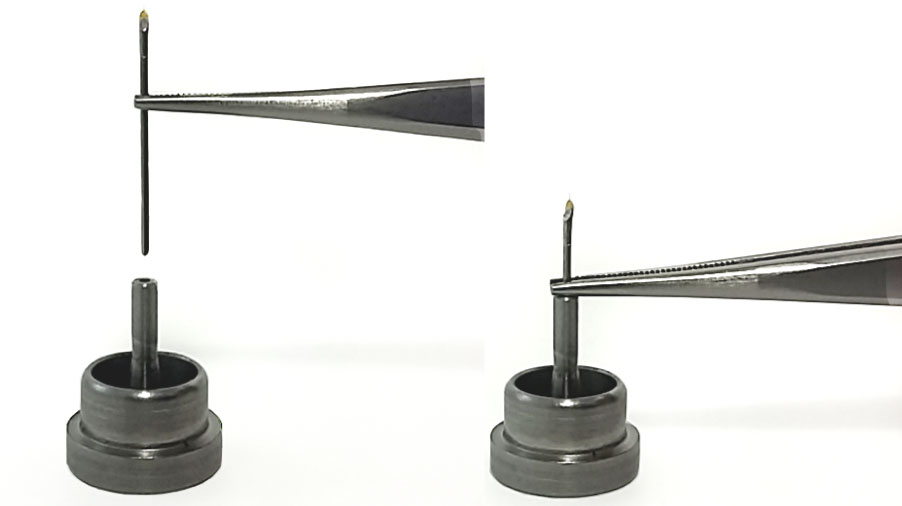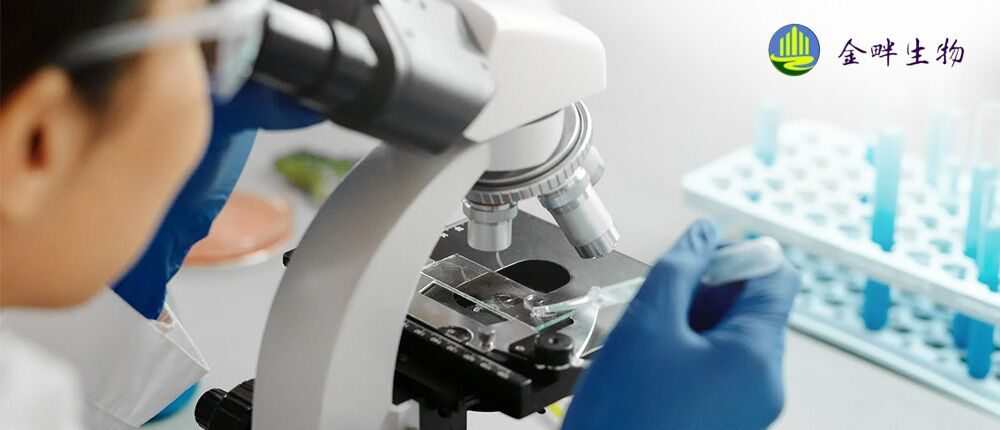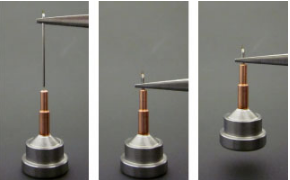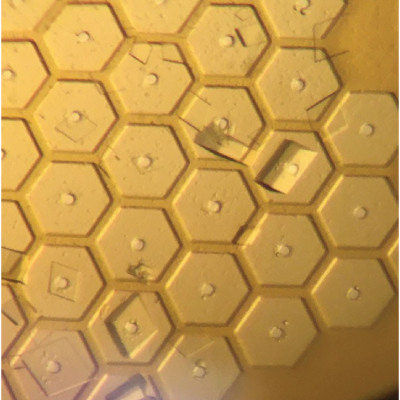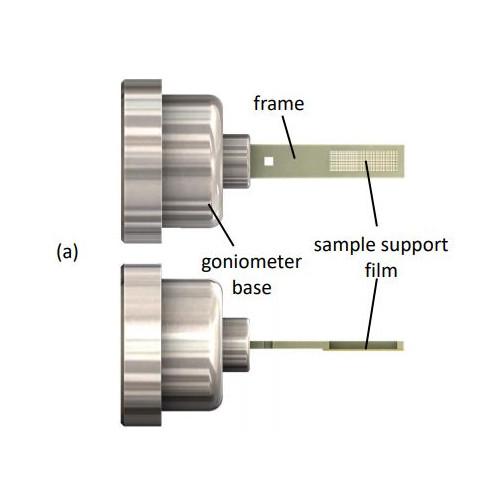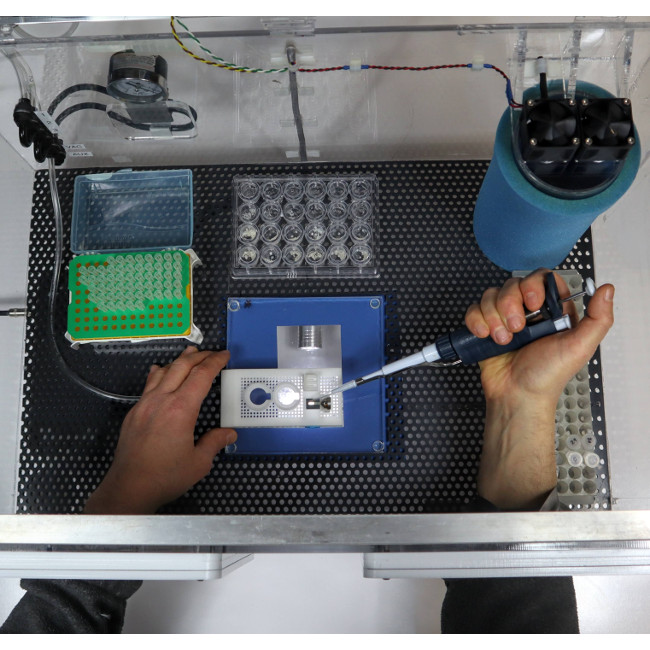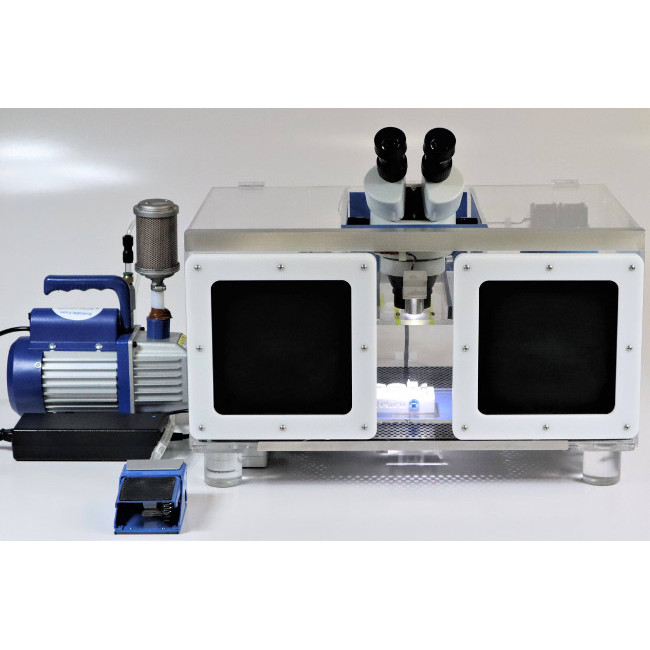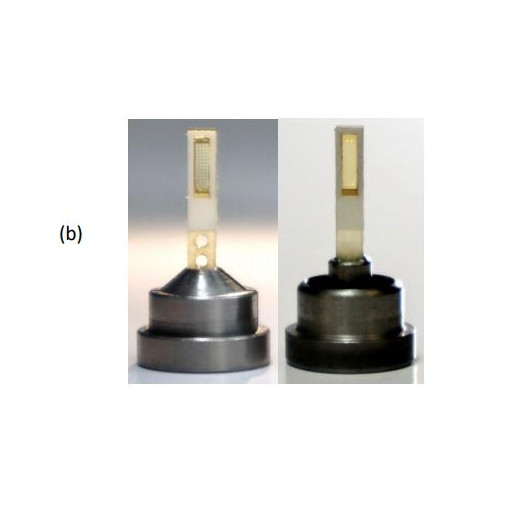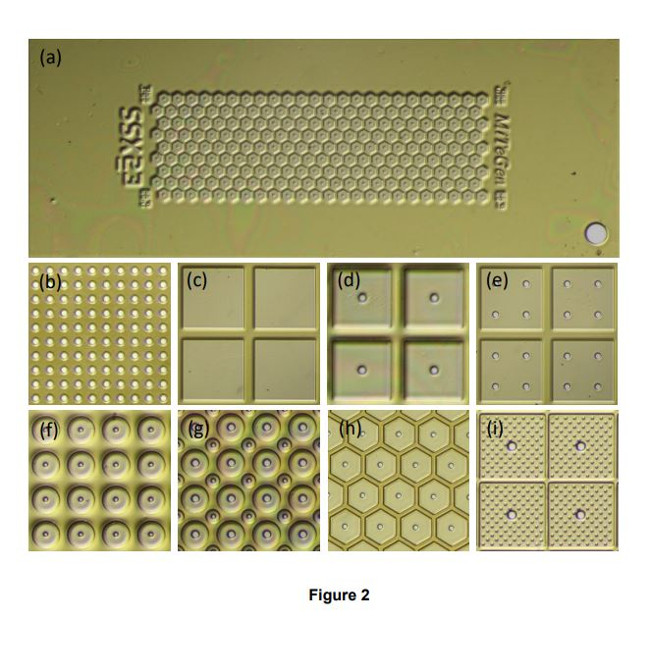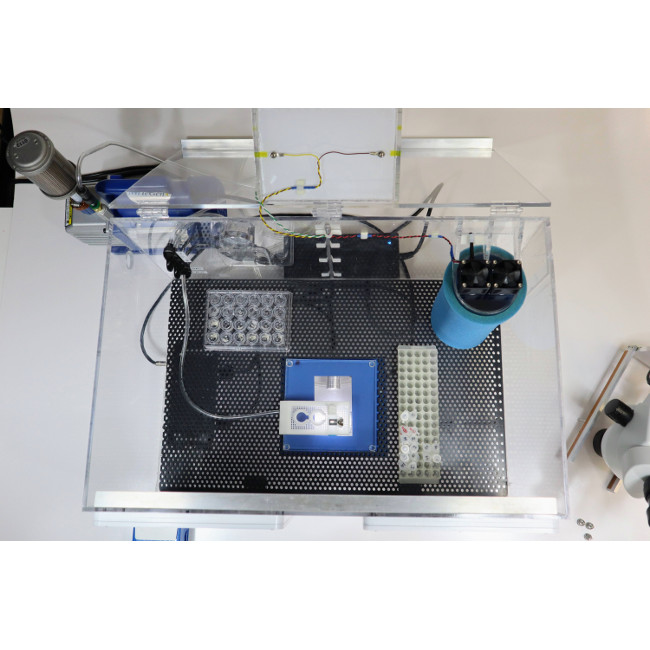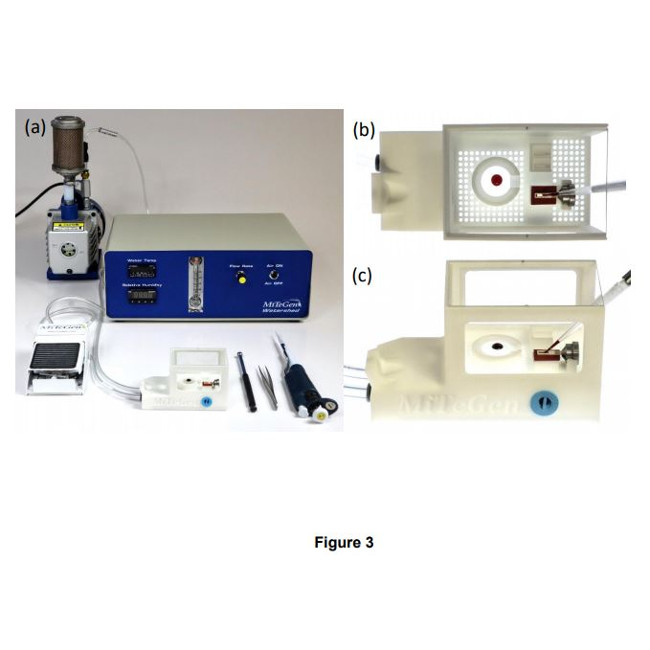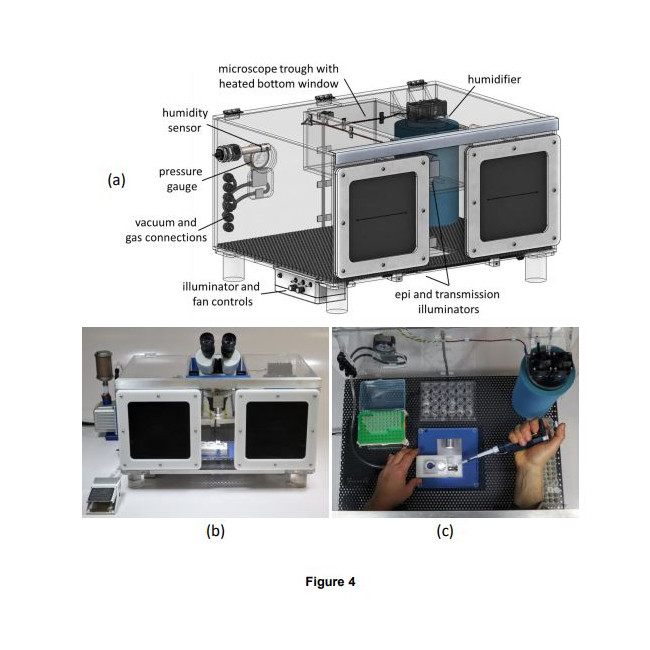The Crystallography Sample Support system is an integrated system for preparing samples for several types of crystallography research. This system integrates and improves upon previously demonstrated concepts to deliver a versatile and high-performance solution.
The systems several salient features are:
- The sample supports are compatible with existing infrastructure for home source and mail-in SR crystallography, including sample handling tools, storage cassettes/pucks, automounters, and goniometer stages. This reduces overall cost and increases opportunities for data collection.
- A single sample holder platform accepts diverse sample support film designs for different size/shape crystals that aid in achieving regular or dispersed crystal positioning.
- Imaging of microcrystals as small as 1-2 µm over the entire active area of the support – not just in wells – is straightforward using both standard visible light microscopy and laser scanned nonlinear excitation modalities due the very thin polymer windows in each well, the thin polymer walls between wells, easy removal of crystal-contrast reducing surrounding liquid, and polyimide’s weak TPEF and zero SHG signals. IUCrJ BIOLOGY | MEDICINE research papers 23.
- With one or two stages of humidity control provided by the humidity-controlled sample loading station and the humidified glovebox, dehydration of crystallization drops and crystals – a critical issue when loading microcrystals for room temperature data collection – can be eliminated. As-grown crystal isomorphism is maintained, scaling and merging of diffraction data from many crystals is improved, and the number of crystals required for structure determination is reduced.
- Foot-pedal modulated suction within a humidified environment gives effective control of solution and crystal flows needed to achieve desired crystal positioning (e.g., random dispersion or at regularly spaced holes.) Positioning over holes can also be achieved by growing crystals in situ using vapor diffusion.
- Crystal position control is achieved using only thin polyimide films with micropatterned features only ~5-20 µm tall. Wells/walls defined by thick (130-250 m) substrates (e.g., silicon, polycarbonate) are not necessary. Background X-ray scatter is low at all positions on the sample support. Diffraction data can be collected from essentially all crystals on the support, not just those located over holes or windows, increasing efficiency of crystal use. X-rays can be incident from and diffracted through a wide angular range without encountering the support frame. Large sample support rotations eliminate data collection issues caused by preferential crystal orientation, and complete data sets can be collected from suitably large individual crystals.
- For room temperature data collection, ~4 µm Mylar sealing films provide adequate protection against dehydration for data collection on a timescale of ~1-2 hours. For room temperature storage and shipping, sealed samples can be stored with reservoir solution in vials, Eppendorf tubes, and multiwell plates.
- Crystal cryoprotection is simplified and made more effective. Cryoprotectantcontaining solutions (or oils) can be deposited on crystals on the sample support, and then withdrawn using suction through the support’s holes; repeating this deposition and removal two or more times can efficiently remove all solvent initially present on the crystal surface, eliminating the primary source of ice diffraction in cryocrystallography (Parkhurst et al., 2017; Moreau et al., 2020), and minimizing background scatter from excess cryoprotectant.
- For cryogenic temperature data collection, samples can be directly plunged in liquid nitrogen, and stored, shipped and handled in the same way and using the same tools as standard loops in cryocrystallography. IUCrJ BIOLOGY | MEDICINE research papers 24
- The supporting polyimide film is much thinner and has much less thermal mass per unit area than standard ~25 µm thick cryoEM grids. If ~1-2 µm crystals are used and excess solution carefully removed, cooling rates well in excess of 50,000 K/s (Kriminski et al., 2003; Warkentin et al., 2006), within a factor of ~10 of those achieved in typical cryoEM practice (>250,000 K/s), should be achievable using current state-of-the art LN2-based cooling methods. Consequently, capture via thermal quenching of roomtemperature biomolecular conformations should be nearly as effective using protein microcrystals as when using protein solutions on cryoEM grids (Kaledhonkar et al., 2019).
The Crystallography Sample Support system consists of several components, these are:
Sample Loading Box – A humidified sample preparation box with optical microscope and vacuum sample wicking
Sample Supports – Sample Supports (Meshes) pre-mounted into automounter-compatible bases
Sample Seals – Room temperature seals
On-support crystallization plates designs
The Crystallography Sample Support system has several use cases in crystallography. These include:
For conventional crystallography using nylon loops and microfabricated loops/mounts. Unlike for loop mounted crystals, there is no “fishing”: multiple crystals are simply deposited (with their mother liquor and any protein or PEG skins) on the support film. Excess liquid is easily removed, background scatter is reduced, and cooling rates are increased. Crystals are confined to a plane adjacent to the support film, simplifying imaging and reducing the chance that the X-ray beam illuminates more than one crystal. Cryoprotection is conveniently performed on the support, with little risk of crystal damage or loss.
For in situ crystallography, the present sample supports have an advantage over some goniometer-base-mounted crystallization devices of being fully compatible with beamline automounters and other high-throughput hardware. The present system also allows mother liquor to be suctioned off after crystallization without risk of crystal damage or dehydration to reduce background scatter and simplify cryocooling.
For serial synchrotron crystallography the Crystallography Sample Support provides a comprehensive and highly flexible solution. Moreover, because sample preparation and handling is simplified, sample damage and dehydration are minimized, sample imaging is improved, background scatter is reduced, cryoprotection is simplified, and cooling rates are maximized, this system has excellent potential to replace conventional loops and mounts and associated protocols in a large fraction of biomolecular crystallography applications. Structure determinations, especially at room temperature where crystallography maintains a major advantage relative to cryoEM — typically require not just one crystal but many, and that the crystals be highly isomorphous. The present integrated system is optimized for this task and will allow much more efficient use of crystals and synchrotron beamtime.
For room temperature crystallography the one or two stages of humidity control provided by the humidity-controlled sample loading station and the humidified glovebox, dehydration of crystallization drops and crystals – a critical issue when loading microcrystals for room temperature data collection – can be eliminated. As-grown crystal isomorphism is maintained, scaling and merging of diffraction data from many crystals is improved, and the number of crystals required for structure determination is reduced. In addition for room temperature data collection, ~4 µm Mylar sealing films provide adequate protection against dehydration for data collection on a timescale of ~1-2 hours. For room temperature storage and shipping, sealed samples can be stored with reservoir solution in vials, Eppendorf tubes, and multiwell plates.
Do you have a question concerning how the Crystallography Sample Support system might apply to your research? Contact us using the contact form found under the far right hand side tab.
